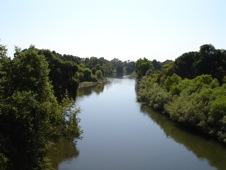
The Tuolumne River Trust’s Paddle to the Sea project concludes today on the San Francisco waterfront. This is another journal entry from Emilio Martinez, one of two paddlers who traveled the entire route, from Yosemite to the Golden Gate.
Emilio Martinez: Return to the Valley
The surprise for the day was that my old stomps look completely different from the vantage point of a kayak on the River’s surface. Some visuals betokened our peculiar Central Valley “look:” the sudden appearance of palm trees behind the oaks and willows; the five bright yellow shopping carts submerged or waiting on the banks for their shiftless owners; and the three homeless sleeping bag spots.
All told, for the first time in my life, the exposed flanks of the Tuolumne were a genuine joy to behold.
A few more things of note, some nice, some just off-putting: the clarity of the water disappeared as we progressed from Fox Grove (Hughson) toward Modesto, going from a fairly deep green of decent transparency to the opaque silt-colored, pale oil-green that we Modestans are quite used to. Not only that, the counter breezes and slowing current acted like a turgid brake on our once swift progression on the water; and of course the air became redolent with–something–either fermenting processed vegetable matter (from where?) or the fertilizer smells wafting over the River from the nearby farm fields. I don’t know.
Besides, the obvious enjoyment of seeing your familiar haunts appear new, fresh, and full of the variety and appeal that Nature’s fecund imagination can contrive, was just sublime. And the River yielded some surreal grace notes, too, specifically in the form of an exquisitely colored horse, sporting every imaginable shade of black and white, lounging serenely underneath the Mitchell Bridge, a place I usually associate with graffiti, industrial consumer detritus, and shiftless “recreational” types: this image shall always remain in my conscious as almost mystical, an ancient ancestral avatar.
Modesto
If the Tuolumne may be considered an emerald queen in its Sierra manifestations, imprisoned and ghostly nobility during its Don Pedro phase, and a country beauty during its descent from La Grange to Waterford, then perhaps the best description of Her Majesty in Her Legion Park – to – Big Bend garb is that of Cinderella. What I mean is that after the Tuolumne’s creep through the homeless camps, fishing holes, arson-burned river banks, defunct Dennet Dam, past sunken fishing boats (five at least), felled floodplain almond trees, topped with a good dousing of cow muffin-perfumed swamp gases, even a queen emerges covered in the cinders and muck of real life as we know it in these troubled regions.
Nonetheless, the “Paddling to the Sea” company was fine and filled with story, song, and revelation; their faces fair and wise; their hearts still courageous enough to brave possible death by choosing life; and their eyes and ears eager to identify the symphony of wildlife that still calls the Tuolumne its home (today’s additions: dogs, crows, palm trees).
Our crew of Tuolumne River Trust personnel and their Grateful Rowers have been at it at least five-days-straight on the River (not counting at least three months of advance preparation on the part of TRT) and we are battered and bruised but still strong and excited by the new face that the River presents every day with each new bend.
So, perhaps fittingly, we began today’s ten-mile row on the nascent topology of the future “Gateway Park” beneath the 7th St. “Lions’ Bridge,” a place where ornate four-foot-high crucifixes memorialized the tragic death of 14-year-old Jeremy Wilson, a drowning victim of the ancient, defunct, and evil Dennett Dam, and ended it at the current “Big Bend” renovation site, where thousands of newly planted trees no higher than year-old-babies dotted the landscape in their blue and red ribbons–all a product of the indefatigable efforts of the TRT’s committed humanity.
I leave you with one image that marks the end of today’s trip in memory: the pale blue gauze of the Coastal Ranges slowly emerging from the horizon to steadfastly gaze back at us from beyond Westley, the small migrant town of my childhood days, the place where the River first entered my consciousness as something to be feared and revered: to many a theologian these are the two faces of the sacred.
Amen.
I want to end on the positive note here. I want to give credit where credit (and kudos) must be given: every one of the human representatives involved in this venture have displayed nothing but stellar professionalism, humanity, and good cheer: from the Hispanic Leadership Youth Council teens to the TRT (Tuolumne River Trust) people–especially the latter, who’ve had the huge task of dealing with boats, people, hunger, and rallies. I cannot imagine an undertaking of this scope being carried out in a better manner by better people, under more challenging conditions, or for a greater cause.
